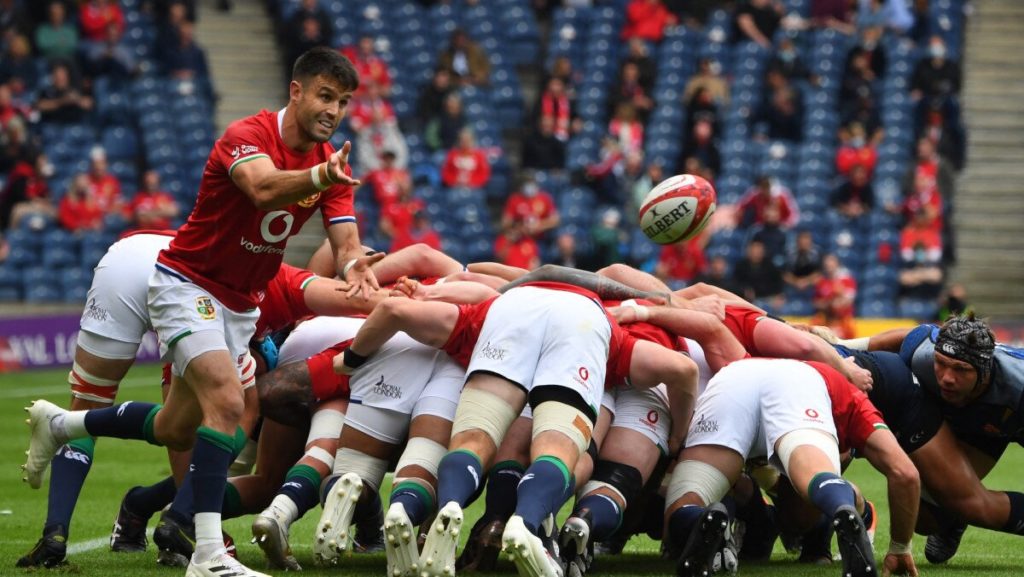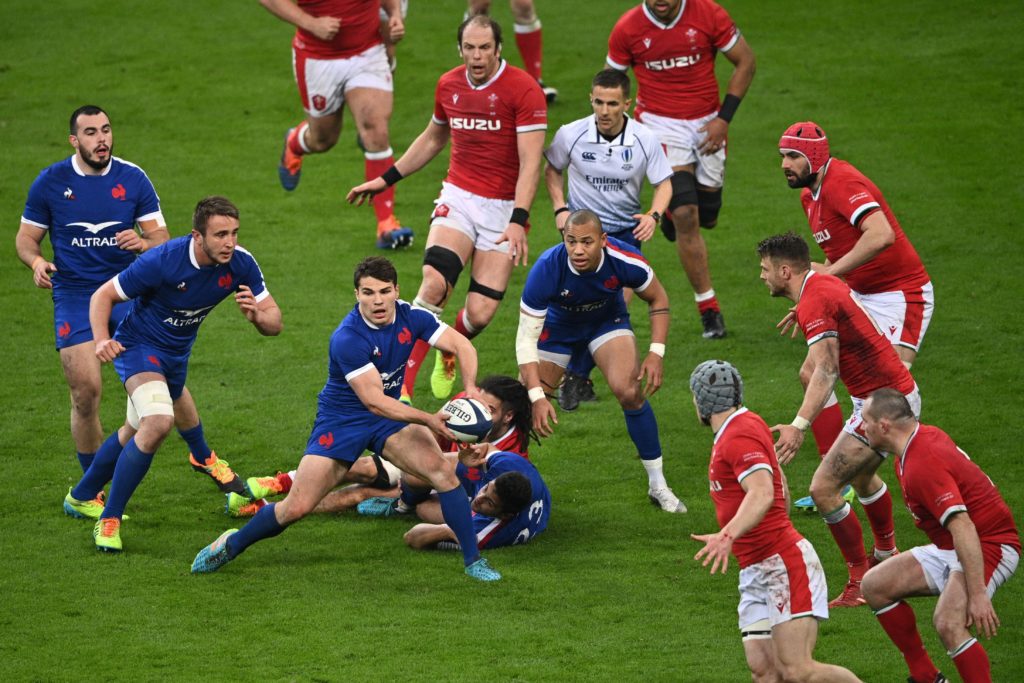Throughout the Six Nations it looked like international rugby might be spinning towards a brave new world where teams were once again prepared to invest more in their attack than their defence.
That sense was amplified when France and Australia played out a thrilling three-test series in July and New Zealand and Fiji ran at each other with the sort of desire and regularity that defines the game in the Pacific.
At about the same time, the British and Irish Lions named a starting team for the first test against the Springboks which, if it hadn’t been leaked in advance to The Times, would have caused significant surprise.
Head coach Warren Gatland was brave enough to drop a few big names and select ball handlers and runners instead. He picked a XV that looked determined to try to run the Boks off their feet by playing a bit of rugby.
Out went senior halfback Conor Murray – the most conservative footballer on the planet. Nor was there room for Owen Farrell – the Englishman who sometimes makes even his most loyal supporters want to tootle off to watch grass grow instead.

Welsh fullback Liam Williams missed out to the enigmatic Stuart Hogg and with one team selection Gatland had us all believing that we stood on the cusp of revolution.
When the Lions then went on to win that first test, there was a new wave of optimism that the sport was emerging out of one of its more prolonged periods of lowest denominator strategising.
If the Lions, who four years ago dragged most of the world into a defensive dungeon, were embracing pass and catch rugby then it really did feel like the darkest days of relentless box kicking were over.
But by the end of the second test, which the Springboks won with what can only described as traditionally, muscular, low-risk Springboks rugby, the clouds regathered and a dark gloom engulfed the international community again.
The Lions lost their way horribly. The sense of possibility they carried in test one strangely disappeared and from being a team with adventure in their soul, they transitioned into one with the imagination and ambition of a brick.
In contrast, just a few hours before the third test kicked off in South Africa, the All Blacks beat the Wallabies 33-25 in a game that saw eight tries after both teams managed to finally find some cohesion.
What followed were two of the most turgid and uninspiring tests of recent times. Fans were treated to 160 minutes – it was actually nearer 200 given all the stoppages and need for deliberation by the officials – of smash, bash, kick chase that highlighted that without ambition, rugby is as unwatchable as it is unfathomable.
The series finished to scathing reviews from the UK media who felt the tour had dragged the game to a place where it can ill-afford to be.
In contrast, just a few hours before the third test kicked off in South Africa, the All Blacks beat the Wallabies 33-25 in a game that saw eight tries after both teams managed to finally find some cohesion.
It was a test that never lacked for intent or attacking ambition even when the execution was struggling and it confirmed that different teams will respond to pressure in different ways.
New Zealand and Australia are both desperate to win the Bledisloe Cup and both looked to play fast, wide, ball-in-hand rugby to do so.

It’s the natural default setting for both teams and when they feel the pressure – they both respond to type, which in both their respective cases is to up the speed, push the passes and take more risks.
As All Blacks coach Ian Foster said of Australia: “They look like they are trying to do a little bit more on counter-attack. They are a good Australian team that wants to play a skill-based team and a fast ruck and run game.”
The All Blacks are much the same. They want to play at pace. They want to use their vast range of skills and athleticism and so reverting to a kick-chase game is not really in their mind-set.
Their natural style is to keep the ball in hand, move it wide and make the contest aerobic. When they meet a like-minded team such as the Wallabies, the rugby can be frenetic and fantastic – high-paced and dramatic, with endless thrills and spills.
The scorelines involving these two go a long way to painting the picture of what happens when two teams play with an attacking intention and a desire to win rather than not lose.
What we predominantly saw in the Six Nations was something closer in style to the Bledisloe Cup. For the first time in an age, Ireland and Wales were happy to keep the ball. So were England and Scotland, but perhaps the real game changers were the French.
These two don’t do 9-6 or 15-12. The lowest scoring game they have had in the last decade was the 16-all draw last year in Wellington – their respective first tests of the season and one played in atrocious weather.
The 33-25 scoreline of the opening test is about the norm and rarely if ever will one or other side not score a try.
What we predominantly saw in the Six Nations was something closer in style to the Bledisloe Cup. For the first time in an age, Ireland and Wales were happy to keep the ball. So were England and Scotland, but perhaps the real game changers were the French.
They have found a desire to play like teams of yesteryear, something they reiterated in Australia last month.
Having left most of their best players at home, France played some clever rugby in their recent three-test series against the Wallabies.
It wasn’t quite France of the 1980s, but it wasn’t so far off either and their resurgence has been built on a new-found desire to play at speed and with width. They have lost the desire to Anglicise their rugby and now it seems as if the majority of the world’s major teams are willing and able to more regularly play a pass and run game.

But this desire is clearly not universal and nor is it consistently employed. The likes of England, Ireland and Wales may prove to be dabblers in this style rather than full coverts, because what we have seen in South Africa is that under pressure, players and coaches from that part of the world go back to what they know best.
And what we can most definitely be sure of is that the Springboks are entirely wedded to kick-chase, forward-orientated rugby.
The second test in the series was arguably one of the worst spectacles produced in a decade summed up brilliantly by Foster.
“I watched it and it put me to sleep,” Foster said. “The Lions series, the one we had here, the one over there, it’s become very tight, almost risk-free type of series, aren’t they? Teams are almost afraid to play, they are just relying on a low-risk strategy,” he said.
“So we are seeing two teams who desperately want to win a big series playing low-risk, highly-effective rugby.
“Both of them are good at the close contact stuff, the close-quarter fighting, the kick and chase, and the pressure game. Two teams playing a similar style, it’s a bit of a slugfest.”
The Boks keep winning when they take zero risks and hence they have no compulsion or need to change.
It turns out then that test football can’t free itself entirely from the suffocating grip of rush defences and box kicking halfbacks. Not when the stakes really matter and not when conservative rugby continues to be so successful.
The Boks are world champions on the back of a gameplan that is not one likely to interest the rugby romantic. No one does defensive rugby quite like them and they are the masters at sucking opposition teams into playing the same way as them.
Former Scotland coach Matt Williams put it like this: “For over 25 years the Springboks have mastered a gameplan with a simple formula. Select a powerful punter who will kick the ball into the opposition half.
“Forge a dominant forward pack that will scrummage and maul their opponents off the park. Select a goal kicker with a success rate of 90 per cent plus.
“Then add a bucket of supreme physicality and bash anything not wearing a green jersey. A simple, negative, boring, yet highly effective strategy.”
The things is, however, the Boks keep winning when they take zero risks and hence they have no compulsion or need to change.

“There is a plan behind everything,” said Springboks assistant coach Deon Davids last week. “When we execute stuff it is not about being boring, it is about understanding what we want to achieve.
“In doing so, we create enough opportunities to play with the ball in hand and score tries. I believe in our approach and where it leads us.
“I was not with the team then, but the same narrative was there when the Springboks won the 2019 Rugby Championship. It was the same when they won the Rugby World Cup the same year.”
And so what we have now is a tale of two rugby movements. There is the free-flowing, high risk style and the kick it away, crush the life out of them style.
When high risk meets high risk, the game opens up. When low risk meets low risk, it can be a long and torturous process seeking who will crack first.
If the game has one larger goal this year it is for higher risk rugby to find a way to defeat low risk rugby when the two styles meet. That’s why this year’s clashes between the All Blacks and Springboks will be pivotal.
And when low risk meets high risk, the odds are too heavily stacked in favour of the former emerging as the winners.
If the game has one larger goal this year it is for higher risk rugby to find a way to defeat low risk rugby when the two styles meet. That’s why this year’s clashes between the All Blacks and Springboks will be pivotal.
These two games, presuming they are played, could go a long way towards pushing us closer to that braver world where higher risk rugby becomes the norm even when the pressure is greatest.
“You have got two teams over there who want to get up,” said Foster of the Lions series. “Their linespeed is really strong and it is all about stopping. We have been criticised in the past for not being able to play through or around linespeed but what you are seeing is two teams who don’t like playing against linespeed either.
“So what do they do? They kick and so that is the answer if you are not willing to play more of a risk-based game and everyone will choose a different way.”


Comments
Join free and tell us what you really think!
Sign up for free